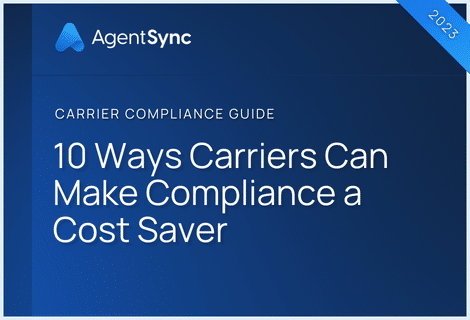

Historically, it’s pretty tough for carriers, agencies, and MGAs/MGUs to find and recruit insurance producers in any targeted way. But for insurance companies to stay competitive in today’s insurance landscape, they need to use accurate data and insights to vet and recruit great producers and downstream partners.
What are the indicators of a good insurance producer?
That really depends.
Some clear red flags—such as regulatory actions—indicate whether a producer won’t be a good fit. Regulatory actions include DUIs, selling outside of a license, selling products that consumers can’t afford, or using deceptive marketing tactics. These actions are a good indicator of the quality and character of a producer, but they’re not the only thing insurance companies should take into account when recruiting producers.
Finding a good producer depends on a company’s specific needs.
Data on what carriers they’re appointed with, which lines of authority they specialize in, and how much experience they have is incredibly valuable for insurance companies but typically isn’t easily accessible or affordable.
Why is data so hard to come by in insurance?
In any industry other than insurance, companies can buy lists of demographic data to inform outreach for hiring. These lists typically include details such as contact information, profile information, and website traffic activity.
By tracking behavior signals as metadata, organizations can reach out to prospective hires in an informed way that syncs cross-departmental goals—across sales and marketing, for instance—to align overall organizational strategy. That doesn’t exist for insurance producers.
Insurance producers are a very elusive population from a digital footprint standpoint. With a median age of 49, many insurance producers don’t even have a website. As a result, there aren’t many sources of truth where you can look at quality data across insurance distribution channels. And for MGAs and carriers looking to hire a particular profile of producer or A/B test specific channels, there aren’t a whole lot of levers they can pull to do that.
The data that is available to insurance companies is segmented across a number of legacy systems. Beyond that, it’s very expensive and isn’t updated or refreshed with any regularity. But many insurance carriers and agencies miss out on how much data they already have locked in their legacy systems.
Revolutionizing insurance distribution channel strategies and producer recruiting with better data
Part of leveling up your distribution strategies is going to involve better-leveraging your existing tech, and there are a number of ways to do that using AgentSync. By understanding your compliance data, you can get insights into other relationships your existing distributors have, and then action on those insights for a more competitive and cost-effective business.
That’s why insurance carriers and agencies are faced with the age-old question of growing organically vs. via mergers and acquisitions (M&A). But either way, some of the best growth strategies for AgentSync Manage and ProducerSync API users rely on one set of data points: Producer appointments.
How insurance carriers and agencies leverage appointment data for organic growth
Organic growth is often slow-going, but some of the easiest wins come less from explosive opportunities and more from growing your margins through internal efficiency. This means making use of Just-In-Time appointment processes (more on this later), as well as the ability to run a report and see in what states your producers hold licenses and appointments. If you integrate your appointment data with your commission payment system, then you can also see:
- Are your producers licensed and appointed with your carrier in states where they aren’t writing business for you, presenting the opportunity for you to terminate that state appointment OR representing an opportunity for you to encourage them to sell?
- Are your producers licensed in a state where they aren’t appointed with you, presenting more opportunities for you to expand?
- Who else are your producers appointed with? This may be competitive intelligence for you to understand who your independent producers are working with and who has their foot in the door.
- Are there lines of business or lines of authority that you don’t currently write that a lot of your producers hold? That could represent an area of possible expansion, where your producers are already working.
How carriers and agencies can leverage AgentSync for M&A growth
The same business intelligence reporting that powers organic growth can also power M&A. With AgentSync Manage, our users can choose to draw in a full report of a producer’s appointment data across all states. Being able to understand what relationships your downstream producers and brokers already hold can give you key information for “paths of least resistance” for new relationships. By getting visibility into what other carriers have relationships with a producer, you can identify which other carriers you could form relationships with, as an agency, or who is an emerging potential partner.
Armed with that data, agencies, MGAs, and carriers can prioritize their funnel and target industry segments, proactively deciding what their distribution channel should look like. As a result, they’ll be able to rethink how they run their business, revolutionizing the insurance industry in the process.
Just-In-Time appointments: Pay only for the producers who produce
Organic? M&A? Either way, once a company finds a slate of potential producers, not every producer will be a fit for every line of business in every state. While carriers don’t need to appoint every potential producer they come across, they also don’t want to miss out on the opportunity to work with a great producer, and finding the diamond in the rough isn’t easy. Appointments cost an average of about $50 per producer per state per year. For carriers with hundreds of thousands of producers, the cost of appointments can add up quickly.
Plus, typically, a carrier will see 20 percent of their producers writing 80 percent of their business.
Many states offer Just-In-Time (JIT) appointments to help carriers offset appointment costs for producers who aren’t writing business. But the process of managing Just-In-Time Appointments without technology is simply too cumbersome.
We built our JIT processing system to help our customers pay only for the producer appointments they need. It gives carriers the freedom to hire the best producers out there without unnecessary appointment costs and the risk of non-compliance through insufficient licensure.
Technology: The future of insurance recruiting
Technology isn’t going anywhere, and neither is innovation, in fact, it’s just getting started. As insurtechs continue to streamline and improve workflows across all business functions—from compliance to recruiting—there’s simply no way to turn back to the past. And why would we want to?
Using tech-forward insurance distribution channel management systems throughout the producer lifecycle saves insurance companies money, saves employees time and headaches, and helps place producers with the insurance companies in which they’ll thrive. Learn more about how AgentSync helps to revolutionize the producer recruiting process.

